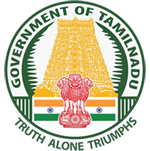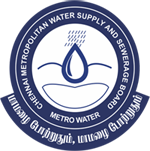



Chennai Metropolitan Water Supply and Sewerage Board
Drinking water is one of the essential requirements for existence for live beings. Surface and ground water are the two major sources of drinking water. Drinking water supply in urban areas is mostly centralised and is mostly from surface sources like natural or impounded reservoirs. As the population density and usage levels are comparatively high in urban areas, water agencies construct, operate and maintain huge surface water dams and reservoirs for meeting their water demands. However, the individual house holds in urban areas have their own bore wells/open wells to cater the water needs other than potable. The no.of such wells is very high due to high density of the houses. In rural areas, ground water is the main source of drinking water. In earlier days people use to collect drinking water from open wells and ponds that belonged to the community.
With the advent of bore well technology and the consequent effort by various water organisations, the scenario of rural water supply has considerably changed. The traditional methods and practices are given least importance. Government Organisations have given priority to provide protected water supply to the villages through rural water supply scheme. Bore wells are drilled and water from overhead tanks is distributed through supply mains. Statistics reveal that about 85% of rural water supply are from the ground water sources. People are happy with these water supply systems as it entails them low cost or no cost and freedom from maintenance responsibilities.
New trends in ground water exploration, increased access to drilling rigs and accessories, combined with the Government policies on subsidised power supply to agricultural pump sets resulted in massive increase in the number of Agricultural bore wells. Such localised extraction of ground water for drinking and irrigation purposes beyond the recharge potential of the areas resulted in gradual decline in ground water level.
Indiscriminate exploitation of ground water rendered many bore wells dry either seasonally or completely. To overcome such a situation, bore wells and tube wells are drilled to greater depths. This has further complicated the situation in some areas where higher concentration of hazardous chemicals such as fluorides, arsenic and nitrates are observed in these waters, in addition to lowering the water table. Discharge of untreated effluents into surface water streams and lakes by industries resulted not only in contaminating these surface waters but also the ground water bodies. In coastal areas like Chennai, over exploitation of ground water resulted in sea water intrusion thereby rendering ground water bodies saline in these areas. Identification and promotion of simple, reliable and environment friendly technologies are necessary to overcome the above problems.
Reviving the traditional practices of water harvesting using scientific methods is a potential option. In most of the cities, the water supply sector is facing a number of problems and constraints. The pace of urban development and the increase in population in the urban areas have resulted in exploitation of water resources to the extremes. Fresh water sources are being heavily exploited to meet the demands of urban populace. Frequent failure of monsoon further makes the situation worse.
As surface water sources fail to meet the ever increasing demands, ground water reserves are tapped, often to unsustainable levels. Chennai city and its suburban areas often get affected with water scarcity during the periods of low rainfall. As the dependence on ground water increases during such periods the ground water table depletes faster than normal rate resulting in dry wells and also the incidences of saline water in certain coastal belts. In addition to quantity, we also face problems of water quality due to over extraction of ground water. Unplanned and uncontrolled extraction of ground water would disturb the hydrological balance along the coastal areas which results in possible sea water intrusion.
Hence, it is necessary to take up measures to conserve and augment the renewable water resources in all possible ways. Ground water recharge by rain water harvesting (RWH) is the simple and cost effective way.
Hydrological Cycle

The water evaporates from wet ground, from the leaves of the growing plants and from the lakes and reservoirs. It is carried in the air as water vapour, a gas. When water vapour condenses it changes from gas to liquid form and falls as rain. The rain feeds the rivers and lakes. Rivers carry water to the ocean. Evaporation from land and oceans puts water back into the atmosphere and this exchange goes on continuously. Water goes from earth to atmosphere and back to the earth, in a hydrogeological cycle.
Occurrence of ground water
Contrary to the popular belief, ground water reserves are not in the form of lakes or streams of water inside the ground. Water in the ground is stored in the interstices of soil or rock that forms the earth, which are called ground water aquifers.
Below a certain depth in the ground, the earth is saturated and this is referred as ground water level, the depth of which vary from few metres to hundreds of metre from place to place. The ground water extracted is replenished by the annual monsoon rain.